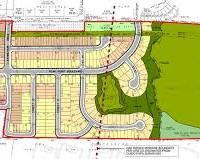What is a subdivision

Citizens’ Guide 4 – Subdivisions PDF (333 KB)
What is a subdivision?
When you divide a piece of land into two or more parcels and offer one or more for sale, you are subdividing property, and the provisions of the Planning Act come into play.
If your proposal involves creating only a lot or two, you may seek approval for a “land severance”. For more details, see Land Severances, No. 5 in the series.
The other means of subdividing land is to obtain approval of a plan of subdivision from the approval authority. This could be the Minister of Municipal Affairs and Housing or a municipality. The authority to approve plans of subdivision can also be delegated to planning boards, municipal planning authorities, committees of council or appointed officers.
Subdivision approval ensures that:
- the land is suitable for its proposed new use
- the proposal conforms to the official plan and zoning in your community, as well as to provincial legislation and policies
- you, your neighbours and your community are protected from developments which are inappropriate or may put an undue strain on community facilities, services or finances.
Problems can result when large tracts of land are split into building lots without the benefit of a formal approval process. People have found out, usually too late, that the lots they have purchased are not on a registered plan. It may be that the water supply is unusable or the access road is not plowed or maintained. Other purchasers have found out that the ownership or title to their property is doubtful, making it difficult to sell.
Who is the approval authority for plans of subdivision?
The councils of some upper-tier, lower-tier and single-tier municipalities are the approval authorities for draft plans of subdivision. Upper-tier municipalities may further delegate the authority to approve plans of subdivision to their lower-tier municipalities. Municipalities may also delegate the authority to committees of council or appointed officers.
In all other areas, the Minister is the approval authority but may delegate the authority to approve plans of subdivision to municipalities, municipal planning authorities, or planning boards in northern Ontario.
To determine who approves plans of subdivision in your area, contact your municipal or planning board office.
What is a registered plan of subdivision?
A registered plan of subdivision is a legal document that shows:
- the exact surveyed boundaries and dimensions of lots on which houses or buildings are to be built
- the location, width and names of streets
- the sites of any schools or parks.
The plan does not show specific building locations; the rules for locating buildings are set out in the zoning by-law and shown on plans as part of site plan approval. (See Zoning By-Laws, No. 3 in the series.)
The plan of subdivision must be:
- surveyed by an Ontario land surveyor
- in general conformity with the municipal official plan and with any county, regional or district plan as well as provincial policies
- approved by the proper authority
- registered in the local land registry system.
A registered plan of subdivision creates new, separate parcels of land and can be legally used for the sale of lots. It should not be confused with “compiled plans” or “reference plans” which are used simply to describe parcels of land.
What is the process for subdividing?
If you are thinking about subdividing your property, discuss your proposal first with local Ministry, municipal, planning board or municipal planning area staff. They can tell you what information, including any special studies, you will need to provide and whether the local official plan and/or zoning by-law provide for your subdivision to be allowed or if further review as to its suitability is necessary.
Subdivision applications are made to the approval authority. This could be the Minister of Municipal Affairs and Housing, a municipality, a municipal planning authority or a planning board. You may be charged a fee for processing the application. To find out what the processing fee is in your area, contact the appropriate approval authority. Ministry, municipal, planning board or municipal planning area staff will tell you about the approval authority in your area.
As an applicant, you are required to fill out a subdivision application form provided by the approval authority.
A typical application form contains both the information identified by Minister’s regulation as well as other information required by the municipality. The more information provided, the less likely delays will occur in the review.
The approval authority may refuse to accept an incomplete application. If an approval authority confirms that an application is incomplete and you, the applicant, disagree with the decision, you have 30 days to make a motion to the Ontario Municipal Board for a determination on the matter. The Board’s decision is final.
You should be aware that if you do not provide all the information identified by Minister’s regulation and the municipality’s official plan, the approval authority may refuse to accept or consider your application. The 180-day time frame for making a decision also does not start. When all the identified and, if applicable, additional information is received, then the 180-day time frame begins. You are encouraged to contact the appropriate approval authority if you need help in assessing what information is required.
The approval authority, or in some cases the municipality in which the proposal is located, must give notice of the application and hold a public meeting before a decision is made. Notice of the public meeting is given at least 14 days in advance, either through local newspapers or by mail and posted notice. Anyone present at the meeting has a right to speak about the proposal.
The approval authority may consult with agencies, boards, authorities or commissions before making a decision.
How are applications for subdivision evaluated?
In considering a plan of subdivision, the approval authority evaluates the merits of the proposal against criteria such as:
- conformity with the official plan and compatibility with adjacent uses of land
- compliance with local zoning by-laws
- suitability of the land for the proposed purpose, including the size and shape of the lot(s) being created
- adequacy of vehicular access, water supply, sewage disposal
- the need to ensure protection from potential flooding.
In deciding on the application, the approval authority shall be consistent with the Provincial Policy Statement.
The Provincial Policy Statement contains clear, overall policy directions on matters of provincial interest related to land use planning and development. The “shall be consistent with” rule means that a council is obliged to ensure that the policies of the Provincial Policy Statement are applied as an essential part of the land use planning decision-making process. It is expected that the approval authority will implement the Provincial Policy Statement in the context of other planning objectives and local circumstances.
(See The Planning Act, No. 1 in the series, and the Provincial Policy Statement, 2005. Both may be obtained by visiting the Ministry website at: ontario.ca/mah or through the government offices listed at the end of this guide.)

What is a draft approval?
Having considered your application, the approval authority may either “draft approve” or refuse your subdivision proposal.
The approval authority must provide a written notice of its decision within 15 days of its decision to the applicant and each person or public body that requested to be notified. When a notice of decision is given, a 20-day appeal period follows.
If your application is draft approved, you will be advised of the conditions that need to be met to obtain final approval and registration. Conditions of draft approval may include: road widenings, the naming of streets, parkland requirements, rezoning of the area to reflect the new uses in the subdivision, and any other municipal requirements. In addition, the draft approval may also establish a time frame within which the conditions must be satisfied or the draft approval lapses.
In most cases, the developer may be required to sign a subdivision agreement with the municipality or planning board to ensure that certain services such as sidewalks and roads are provided after the plan has been registered.
Draft approval amounts to a commitment to go ahead with the subdivision, once all the conditions of draft approval have been met. Lots may be offered for sale after draft approval, but can be sold only after the plan of subdivision has been registered.
How can you get involved?
If you are concerned about a draft plan of subdivision that may affect you:
- find out as much as possible about the draft plan
- go to the public meeting and give your opinions
- discuss your concerns with the approval authority
- write the approval authority.
Your opinions should be clearly expressed to the approval authority by making an oral submission at the public meeting and/or a written submission to the approval authority before a draft plan of subdivision is approved. Failure to make a submission means that you do not qualify to appeal the draft subdivision plan approval. In addition, you should also make a written request if you want to be notified of any change to the conditions attached to a draft approval and to protect your appeal rights.
If you have any concerns, you should make sure that you let the approval authority know about them early in the process. The approval authority will then have time to think about what you said and may make changes before the draft plan of subdivision is approved.
What rights of appeal do you have?
Appeals to the Ontario Municipal Board can be made in four different ways:
- The applicant may appeal if no decision is made within 180 days from the date of receipt by the approval authority of the application containing the prescribed information and, if applicable, any additional information required by the municipality under its official plan.
- The applicant, the Minister, the municipality or planning board in which the proposed subdivision is located and any person or public body that meets certain requirements, may appeal an approval authority’s decision, or any of the conditions of the draft approval or the lapsing provision within 20 days of the notice of decision.
- The applicant, the Minister, the municipality or planning board in which the proposed subdivision is located, and any public body that meets certain requirements, may appeal conditions of approval at any time before final approval is granted.
- The applicant, the Minister, the municipality or planning board in which the proposed subdivision is located and any person or public body that meets certain requirements, may appeal any changed conditions imposed by the approval authority.
Appeals must be filed with the approval authority accompanied by reasons for the appeal and the fee required by the Ontario Municipal Board. Contact the approval authority for more information.
The Ontario Municipal Board is an independent administrative tribunal responsible for hearing appeals and deciding on a variety of contentious municipal matters. (See the Ontario Municipal Board, No. 6 in the series.)
What are the powers of the Ontario Municipal Board?
A person or a public body that makes an oral submission at a public meeting, or submits a written submission prior to the approval of a draft plan of subdivision, may appeal an approval authority’s decision.
When a decision is appealed, the Ontario Municipal Board will hold a hearing where you will have the chance to present your case. The Ontario Municipal Board can make any decision that the approval authority could have made on the application.
The Ontario Municipal Board also has the power to dismiss an appeal without holding a hearing. (See the Ontario Municipal Board, No. 6 in the series.)
Appealing a decision to the Ontario Municipal Board is a serious matter. It can take considerable time, effort and in some cases, money, for everyone involved. A hearing may last for a few hours if the matter is quite simple, but for more complicated matters a hearing can last for several days or even weeks.
The Ontario Municipal Board must have regard to the local decision and make its decision based on the facts presented at a hearing. The decision should generally be limited to the information and material that were before the approval authority whose decision is appealed. New information and material can be introduced at a hearing. However, the Ontario Municipal Board may, on its own initiative or by motion of any of the parties, give the approval authority 60 days to reconsider its decision and make a written submission if the new information could have materially affected the approval authority’s decision.
The Ontario Municipal Board also has the discretion to dismiss an appeal if it constitutes an abuse of process, such as repeating the submission of an application that has recently been dealt with by the municipality and/or the Ontario Municipal Board. An appeal can also be dismissed by the Ontario Municipal Board if the application before it is substantially different from that which was before a council at the time of its decision.
When can a subdivision be registered?
When all conditions of the draft approval have been met, final approval is given and the plan of subdivision is registered in the provincial land titles or registry system. The developer may then go ahead with the sale of lots in the subdivision.
You should be aware that considerable time may pass between draft approval and actual registration of the plan. However, the approval authority has the power to provide that draft approval will lapse after three years. It also has the power to give a further extension of draft approval.
When must services be provided?
Although many services for new subdivisions are not provided until well after registration, most municipalities insist that they be in place before occupants move into their new home. The applicant may be required to sign a detailed subdivision agreement, which is sometimes registered on the title of the property and legally binds future owners to its conditions.
Are condominiums a form of subdivision?
Yes. Condominiums are a form of property ownership in which title to a unit, such as an individual apartment in a high-rise building, is held by an individual together with a share of the rest of the property, which is common to all of the owners.
Condominiums can involve a brand new development, or an existing rental project which is converted to condominium ownership. They can apply to any type of residential building as well as commercial and industrial areas.
A condominium plan is like a plan of subdivision in that it is a way of dividing property. Similarly, plans of condominium must be approved, or in some cases granted an exemption from approval, by an approval authority.
Some applications for approval of condominium descriptions are not subject to the requirements of giving notice of application and holding a public meeting. Vacant land or common elements condominium are subject to notification requirements. Regardless of the type of condominium proposed, the approval authority is still required to give a notice of a decision to approve a condominium description. The 20-day appeal period following the notice of decision applies.
The Subdivision Process
This flowchart focuses on th






